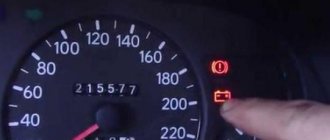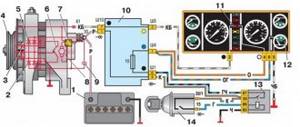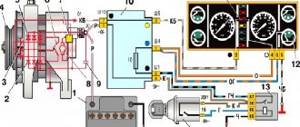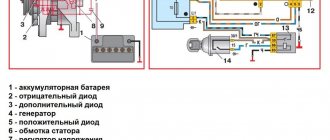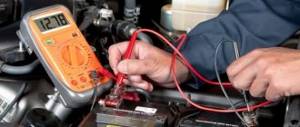Which voltage
must be on the battery when
the car
engine is running. The service life of a car battery is not calculated by the years guaranteed by the manufacturer, but by the number of “discharge/charge” cycles. The more competently the operation and maintenance of the battery
, the less often you will have to take a new one. The question of the voltage rating at the battery terminals worries many motorists.
Everyone knows what it should be “statically” - about 12.6 V. This is the norm. And its value when the engine is running
auto? Will it change or not, and if so, in what direction? Let's figure this out.
If there are no complaints about the battery, then check the voltage at its terminals with the engine running
allows you to diagnose the generator. How to measure the charging voltage from the generator. Charging the battery. In other words, find out how correctly the latter works, and in general, whether it provides charging or not.
No specialist will give a specific answer regarding the voltage level on the car battery. The main reason is that it is not clear what operating mode the engine is supposed to operate in and whether other consumers of electricity are included (or not). These include (who has forgotten) - headlights, lights with turn signals, a stove and a number of others, depending on the car model. The amount of charging current (as well as the voltage on the battery) is partly influenced by air temperature. Not enough people take this into account, but this particular factor leads to some scatter in the device’s readings.
Read:
Let's try to summarize all the data on battery voltage values (in V):
What kind of charging should go to the battery from the generator?
It is traditionally believed that 13.5-14.5V should be supplied by the generator to the battery and this is absolutely enough to replenish the battery costs.
It is worth considering that using a battery with a higher power in a car than the manufacturer recommends also requires the installation of a more productive generating device.
It is necessary to take into account the load that the generator must withstand - it is calculated based on the maximum indicators of all electrical appliances and car systems.
Do not forget that the charging current from the energy-generating device will allow you to start the car in the cold season. In order to avoid problems with starting the car, we recommend purchasing generating equipment, the charge current of which will be approximately 10% of the capacity of the power source. That is, a battery of 100 A/h requires a generator that can produce 10A. Please note that for many cars, 100 amp equipment will operate at its maximum capacity, because the power consumption of the automotive system is in the region of 80 amps. Therefore, the choice of a source generating energy must take into account both the battery capacity and network consumption.
Causes of battery charging failure
The main parameter in the battery charging process is the charge current. Many parameters depend on its value.
Capacity replenishment speed
There is an opinion that for normal battery charging, the charge current should be 10% of its capacity, i.e. with a battery capacity of 50 Amp*hours, the charging current will be 5 Amps. Under such conditions, it will reach its nominal capacity of 10 hours.
Imagine, you were turned on by the wires of another car in the winter, and in order to fully charge the car battery, you need to drive the car for 10 hours straight, that is, drive about five hundred kilometers.
It is believed that to replenish the battery charge to the nominal value, it is enough to drive 30 kilometers in a normal cycle, and in city traffic jams half that. That is, if your work is located more than 10 kilometers from home, this is enough not to worry about recharging the battery outside the car.
The case is different when work is close to home. You spent the capacity when starting the car, quickly drove to work, and then also home. After a week or two, your battery runs out. And not at all because there is something wrong with the car, it’s just the rhythm of the drive.
In this case, you should think about warming up the engine even in the warm season just to ensure that the battery is always charged.
Let's return to the charge current. If it is enough to drive a car 30 kilometers to fully charge the battery, and not 500, as in the example, therefore, the charging current of the car generator is not 5 Amperes, but much higher.
Battery life
The normal battery life is more than five years. Used cars imported from abroad have fully working seven- to nine-year-old batteries on board. There, however, the storage conditions for cars are different, and the temperature in winter is higher.
There are three reasons for the low durability of the battery: violation of the battery charging mode, the quality of the battery, the human factor, in other words, laziness.
Let's start with the first one. If the battery is not charged to full capacity all the time, the plates undergo a sulfation process. Sulfation, or the formation of lead sulfate on the plates, can be compared to a stomach ulcer in humans, only in humans it can be treated, but a battery ulcer is practically untreatable.
There are various methods of complete discharge-charge, charging with pulsed currents. Maybe there is some percentage recovery, but if the battery is completely dead, then alas...
The quality of the battery depends on the manufacturer. Modern technologies only affect the increase in battery capacity while reducing the size and weight, respectively, the amount of lead.
Video - how to check battery charging from a generator:
3 in 1: DVR + GPS informer + radar detector
How to protect yourself from the blinding sun and headlights while driving?
How can a powerful generator hasten death?
We take a 40A generator, and a 60 a/h battery. ACC is deeply discharged. As a result, at a voltage of 14.4 volts from the generator, the charging current can be 20 or 30 amperes. Essentially, it is limited only by the generator's capabilities.
Such a large charging current also destroys the battery plates.
Now the same conditions but the generator is 100A. Now the charging current is unlikely to be limited by the generator, and with a deep discharge the battery will be even larger and will destroy it even more.
We remember that it is good to charge a battery to 1/10 of its capacity. Therefore, the more the battery is discharged while parked (three days in the garage, carrying a light bulb in nature), the greater the charging current from the generator will be.
Again, these are not normal operating conditions, but they do happen. Some more often, some less often.
I have it, but I don’t remember the name. Not the most expensive.
Oh, let it be proof that not only expensive batteries can last a long time. Victor “Stabs” said the same thing about 7 years, and not about expensive ones.
Now is another moment. What voltage does your generator produce? It must be measured: – The battery is FULLY charged from an external charger. – all consumers are turned off, except those that control the engine (ignition, fuel supply). – After starting the engine, let it run for several minutes at speeds slightly above XX in order to compensate for the loss of energy in the battery when starting the engine (not everything is clear, but this will remove the sharp peak charging current).
We measure the voltage at the battery terminals. Something tells me that for Shtubs, and Romanson, and others whose batteries last a long time, the voltage will be close to 14.4 volts. Those. The relay voltage regulator is set to normal voltage. But many RRs, and the nuances in their connections, can produce a charging voltage of 13.4 volts. For example, my RR on the Volga, (new) was set to 13.7 volts. (approximately, but less than 14 for sure). Again, I'm too lazy to look for a book on batteries, but if the battery is charged at this voltage, it will be chronically undercharged. Moreover, by 20-30% (!).
Yeah, I found it: At 14.4 volts the battery is 80% (!) charged! And to recharge the remaining 20%, you need to raise the voltage to 16.2 volts (!). Who does this - practically no one. This means that if the RR is set to 14.4 volts, we are charged to 80%. And at 13.7 volts – 70%.
How to check the alternator voltage on the battery
The potential difference can be diagnosed in two ways - directly at the generating equipment and through the battery. The generator is directly connected to the power source with a thick wire, therefore, to check the level of potential difference, you can measure the voltage at the power source. To do this, you will need special devices - a voltmeter, multimeter or load plug.
The wires of the first measuring instruments are connected to the battery in any sequence. The plug must be connected to the battery terminals with strict observance of polarity. It is generally accepted that the normal voltage in the network should not be lower than 12 volts. At idle speed without turning on all electrical devices of the car, this indicator should be at the level of 13.5-14V. A drop in voltage values to 13.3-13.8 volts is considered acceptable.
At the same time, using conventional testing equipment, you can check the resistance of the generator elements - rotor, stator and diode bridge. Diagnostics of rotary equipment is carried out by its winding. It is necessary to connect the probes of the device with slip rings. If the multimeter gives readings from 2, 3 to 5.1 ohms, then this element is working. The current consumption of the winding should be within 3-4.5 amperes.
Its normal resistance is 0.2 Ohm. The diode bridge is checked by the presence or absence of resistance, the indicators do not matter. The only thing worth considering is that there should not be a zero dimension. Measurements are carried out in pairs - positive output and all plates on this side or minus and all elements.
We remind you that for normal charging of a car battery, the voltage supplied by the generator must be from 13.5 to 14 volts.
Features of battery operation
If you follow basic operating recommendations, you can significantly extend the life of the energy source. If the battery plates are not destroyed, the voltage remains constant. Basic recommendations for battery operation are as follows:
- When starting the engine, all third-party consumers must be turned off. Too high a load, which the battery is not designed for, leads to rapid wear of the structure and evaporation of liquid from the electrolyte. One attempt to start the engine should last no more than 5-10 seconds. Longer load leads to loss of capacity and decrease in voltage. If the engine does not start on the second attempt, you need to check its technical condition.
- The integrity of the wiring is periodically checked . Leaks in the wiring cause the battery to quickly discharge. Leakage current measurements are usually carried out at a vehicle service station.
- In winter, when driving for a long time on city streets at low speed, the generator does not produce enough to power all the electrics and charge the battery. That is why it is recommended to periodically charge the battery using a charger. Due to this procedure, the likelihood of complete battery discharge and voltage drop is reduced, and the service life of the device is increased.
- Terminals must be kept clean . Various contaminants cause an increase in resistance, due to which discharge occurs faster. In addition, water should not get on the surface, since a short circuit will almost immediately damage the power source. To clean the terminals, use a rag and soda ash or ammonia mixture.
We recommend: Description of the Vesta car battery series
Checking the voltage takes only a few seconds using a special measuring device. That is why it is recommended to carry out such a procedure periodically, which significantly extends the life of the energy source.
How many amperes does a car alternator produce per battery?
The current strength required by the electrical system of each car is individual and depends on the number of electricity consumers and their values. And also the charge current must be sufficient to charge the power source.
It is worth noting that ampere readings appear only when there is a load in the vehicle’s electrical system and, accordingly, the battery is discharged. After starting the car engine, the charging current is about 6-10 amperes and drops over time, because the battery is charging, taking on the main energy consumption. If you turn on additional equipment - headlights, radio or heated mirrors, you can see an increase in the charging current values.
When purchasing a generator, pay attention to its technical characteristics, which the manufacturer indicates on the case - that’s where you will find information about the maximum current that will flow to the battery.
In the table below you can see the approximate current values that the generator shows at different loads.
Table 1. How many amperes the generator produces under load.
Level U in winter
Owners of diesel cars are well aware of the situation where starting becomes more difficult when the ambient temperature drops. This is due to the following:
- An electrolyte is used as an active substance that is poured between the plates. This substance is a mixture of distilled water and acid. Low temperature causes crystallization of the liquid, due to which the tt density increases and the capacity decreases. The natural process of crystallization determines why the self-discharge rate decreases as the temperature decreases.
- When the device is fully charged, the drop in capacity does not affect the current rating. That is why there is no need to remove the battery for the winter if it is in good technical condition.
We recommend: Advantages and disadvantages of the Bosch S3 battery
If necessary, you can service the power supply before the onset of winter. Battery electrolyte can be purchased or made independently, and it is used to change the density indicator. The capacity can be refilled by adding distilled water through special holes.
Signs of a generator malfunction
In modern cars, breakdowns of the electrical system are one of the most common. A large number of electronics requires particularly careful monitoring of the operation and condition of the generator and battery, because their failure can immobilize the car. The most common signs of a generator malfunction are:
- battery indicator light on the instrument panel;
- unstable operation of the battery (its boiling over or undercharging);
- different intensity of headlights;
- extraneous sounds from the generator.
If you notice incorrect operation of the car, then perhaps the battery charging current from the generator is insufficient.
All malfunctions of electrical equipment, which includes the vehicle’s energy-generating device, are mechanical (deformation or breakage of fasteners, housing, malfunction of bearings, pressure springs, drive belt, etc.) or electrical (winding breaks, diode bridge malfunctions, burnout or wear of brushes , short circuits between turns, breakdowns, etc.).
Don’t write off a non-working generator: find out if there are repair kits and spare parts. Replace them if possible. If you cannot carry out repair work yourself, then take the generator to a workshop. Many craftsmen will be able to restore the unit at no extra cost and in the shortest possible time.
However, some breakdowns require the purchase of a new device that generates electricity. For example, a failing bearing that is soldered into the generator housing cannot be restored or replaced in most cases.
Remember that failure of this unit can be caused not only by wear and corrosion, but also by poor quality of elements and components; excessive load; external influence of salts, liquids, temperatures.
Other causes of low voltage
A small potential difference in the system is not always associated with a breakdown of the generator or a bad battery. If the diagnosis of these elements does not reveal any problems, then you should pay attention to the following:
- condition of the battery terminals - connection density and oxidation;
- electrical wiring problems - oxidation, violation of its integrity;
- output contacts to electrical appliances;
- correctly selected energy consumers.
Each contact must be tightly adjacent and intact, that is, there must be no formations (for example, sulfation) that will disrupt the flow of current. Incorrect connection of contacts leads to accelerated battery discharge even when the car is not running.
To improve the connection of the elements of the car's electrical system, it is necessary to clean all contacts and restore the integrity of the wires by replacing them or connecting them and wrapping them with insulating tape.
In conclusion, I would like to repeat that stable operation of the car requires constant monitoring of all elements, and the generator should attract special attention. The battery is charged from it and provides electricity to the entire car system. Pay attention to all elements: generator brushes, slip rings, voltage regulator, equipment winding.
The most correct measurements should be carried out when the battery is fully charged and in various modes. Remember that the manufacturer links the characteristics of the generator to the number of engine revolutions - they help produce a certain current.
Detailed video on how to check the generator:
Do you have experience diagnosing an alternator and solving problems in a vehicle's electrical system? Please share your experience and opinion with our readers in the comments. If you have questions about the topics covered, we will be happy to answer them.
The question of the normal voltage of a car battery is questioned by many car owners. After all, the voltage of the battery, as well as its capacity, are important components on which the quality of its work and functionality depend. The battery is one of the most important components of a vehicle. Half of the electronics depend on its operation, and only with its help can the engine be started, so every car owner should know what voltage is correct for his battery. An important point for measuring voltage is a special device - a multimeter
.
Today, many people buy modern cars, but these cars do not have devices that measure “volts”. That is why, in order to carry out the voltage measurement process, it is worth acquiring such a device. It is necessary to check the voltage at least once a month
, this will help you find out about any voltage-related faults and correct the situation in time. In this article, we will address the question of what is the normal battery voltage.
So, in normal condition, the battery should output voltage readings of 12.6-12.7V
.
These values indicate that the battery is fully charged. Also, I would like to note that the indicators may vary, for example, depending on the conditions in which the battery is charged. Many chargers, when fully charged, give completely different values, even up to 13.2V
, and to avoid such readings, you should not measure the voltage immediately after charging, you need to wait at least an hour for the numbers to drop to the required measurements,
from 13.2V to 12.7V
.
If the indicators go in the other direction, for example below 12V, this already indicates that the battery is discharged by 50%
. Therefore, it is urgent to charge the battery, since this state of the battery leads to sulfation of the lead plates, thereby leading to a decrease in battery performance. But many car owners, not being able to recharge on site, start the engine with this voltage, and this is quite realistic and possible if the battery is in excellent condition and does not require repair. And in the case when the readings drop below 11.6V, the battery is practically discharged, in such a situation its further use is impossible without additional recharging.
Thus, from what has been written above, we can say that the normal voltage level is 12.6-12.7V
.
However, as practice has shown, such voltage is rare, generally the indicators are up to 12.49V
, and this indicates that the battery is not fully charged.
But this is not bad, because a decrease in the performance of the device occurs when the voltage readings are below 11.9 volts
.
Now let's look at how voltage behaves under load.
As We have already said, the normal battery voltage is 12.7V.
.
But in practice, a more accurate indicator is the actual one, it ranges from 12.4 to 12.8V
. This way, measurements are obtained without a load on the battery, in a free state.
What is the load for and how to produce it? Everything is very simple here.
The load on the battery is necessary, because with the help of this test, we will check the performance of the battery
. Any battery can withstand normal voltage, but not every battery can withstand the load. If you put a load on the battery, it will begin to produce completely different indicators, so let's check.
The process of this verification is very simple. We load a fully charged battery using a special device that is almost twice the battery capacity.
For example, if your battery has a capacity of 80A/h
, accordingly, we supply twice as much load -
160A
.
The duration of this load should be up to 5 seconds
, no more, and the readings should not be lower than 9 volts; if the readings are lower, this means the battery is discharged or is completely unsuitable for further use.
The main detail of this process is recovery. After the load, the voltage should recover in about 5-6 seconds
to normal.
To find out what condition the battery is in, you need to repeat the whole process, if after the second experiment the readings reach 9 Volts
, then the battery is in normal condition and a charge was needed.
It is important to note that the main feature, thanks to which it is possible to determine the voltage level in the battery, is the density of the electrolyte that is inside the battery. For example, in a normal state of charge, this is 12.7V
, the density of the electrolyte in the battery is
1.27 g/cm3
.
And finally, I would like to write a little about the battery and its voltage in the winter. This problem is the most pressing and frequently asked questions are about exactly this. In severe frosts, the battery is more exposed to danger and is constantly discharged, as a result of which the car does not start. In such cases, special starting-chargers save the day, but some car owners take the battery home at night. So what causes problems with using the battery?
The fact is that at negative temperatures, the electrolytes inside pass through more slowly than at normal temperatures. Therefore, in order to start the engine even in severe frosts, you need your battery to be fully charged; this will ensure a normal level of density and voltage, which will allow starting.
So, We found out what the normal voltage is for a car battery.
Note that there are three main indicators of voltage, such as:
— Actual — Nominal — Under load
We gave an example and described everything in detail using three main indicators. It is worth checking even with a new battery.
. And to ensure that the voltage of your battery is always in normal operating condition for a long time, you need to follow precise rules.
- Firstly
, check all car wires for integrity.
Any current leakage can lead to loss of battery charge. — Secondly
, the battery must be kept clean.
— Thirdly
, any electricity consumers should be turned off before starting the car, as there is a heavy load.
We hope that our article will become clear and informative in resolving the issue with the voltage of your battery. And if suddenly you want to buy yourself a charger to charge the battery, or when the battery is completely discharged, you can always do this in our store by placing an order through the website or by calling.
We will tell you how to properly check a car battery for serviceability using a multimeter and a load plug, what methods exist.
Checking with a multimeter
You need a multimeter - a device for measuring voltage.
If you don’t have it, you can ask your friends or buy it in a store. The device is inexpensive, the simplest one costs 300 rubles. If you carry out electrical repair work more than once, it will come in handy. I recommend buying a digital multimeter rather than a dial multimeter, because... it is more convenient to use. You should not rely on measuring the battery using the car’s on-board computer, because they are wrong. These voltmeters are not connected directly to the battery, which means losses are possible. Therefore, the voltage on them may appear less than on the battery itself.
Check with the engine running
We first measure the voltage with the engine running. It should be from 13.5 to 14.0 V.
If it is more than 14.2 V when the engine is running, this indicates a low battery charge and that the generator is working in overdrive to charge the battery. This does not always happen, for example, in winter there may be increased voltage, because... The battery could have discharged overnight due to the cold temperature. Or electronics detect the air temperature and give more charge to the battery.
There is nothing wrong with increased stress. If everything is fine with the electrical equipment of the car, then after 5-10 minutes the electronics will reset it to normal: 13.5-14.0 V. If this does not happen and it is not gradually reset to the optimal value, then this may result in an overcharge of the battery. It will work at maximum output, which threatens to boil the electrolyte.
If the voltage is less than 13.0-13.4 V when the engine is running, it means that the battery is not fully charging. You shouldn’t immediately run to a car service; first, the measurement should take place with all consumers turned off. This means turn off the music, lights, heating, air conditioning and all energy-consuming devices.
What is the multimeter showing now? During normal operation of the car’s electronics, it should be in the range from 13.5 to 14 V. If lower, it indicates that the car’s generator is not working. Especially when the voltage with the engine running and consumers turned off is less than 13.0 V.
Low readings are possible if the battery contacts are oxidized. So check them out. If there is a coating on them (for example, green), then clean them with sandpaper or a flat file.
How else can you check the operation of the battery and generator?
There is one way. With the engine running and devices turned off, the voltage on the battery is 13.6. Now turn on the low beam. The voltage should drop slightly - by 0.1-0.2 V. Next, turn on the music, then the air conditioner and other sources. Each time you turn it on, the battery voltage should drop slightly.
If the voltage drops significantly after turning on the vehicle's power sources, this means that the generator is not operating at full capacity and the brushes are worn out.
With all consumers turned on, the voltage on the car's batteries should not fall below 12.8-13.0 V. If it is less, the battery is discharged and requires replacement and the purchase of a new one, but we will discuss how to check below.
Checking with the engine off
If the voltage is less than 11.8-12.0 V, the battery is discharged, the car may not start and you will have to light it from another car.
The normal value is from 12.5 to 13.0 V. There is an old and simple method to find out the charge level.
So, a reading of 12.9 V means that the battery is 90% charged, a reading of 12.5 V is 50% charged, and 12.1 V is 10 percent charged. This is an approximate method for measuring the charge level, but it is effective, as confirmed by our own experience.
There is one caveat. If the measurement is taken after the engine is turned off, then one reading is possible, and if the next morning, another. It is better to measure the voltage on the battery before driving.
The battery charge level indicates its ability to hold voltage for some days. If it's fully charged, or hasn't been driven for more than a week, the voltage won't drop much. Otherwise, if the car's battery is discharged, the voltage will drop quickly.
Checking with a load fork
This is an effective way to check the performance of a car battery.
It is based on its results that you can declare whether the battery is charged or not. How to check? To do this, connect the load plug, observing the polarity. The joining time should not exceed 5 seconds. At the beginning of the measurement, the voltage is 12-13.0 V. At the end of the fifth second it should be more than 10 Volts. Such a battery is considered charged and capable of operating under load.
If, when tested with a load plug, the voltage drops below 9 volts, the battery is considered weak and unreliable. In this case, you will have to think about buying a new one.
A car battery is the basis for all electronics in a car. It is recharged by a generator and constantly powers all electrical elements in the system. Its malfunction can lead to improper operation of the car, so it is worth monitoring its performance.
Battery voltage is one of the main indicators of its performance. Therefore, you need to regularly check it and monitor the charge level so that it does not fall below normal. This will be discussed in our article.
Charging check
Diagnosis is carried out using various methods. The main ones are: visual inspection, computer diagnostics and testing using physical measurements.
A caring owner must carry out a visual inspection of the gene and battery at least once every 7 days.
In addition, in the summer it is necessary to monitor the battery electrolyte stages. This is done through the provided battery window or through the light.
The electrolyte can boil out of the battery not only due to extreme heat, but also due to overcharging. That is, the gene can be faulty and produce more current than necessary. Obviously, the result of such a situation will not lead to anything good - the acid concentration will increase, the plates will corrode, and the current will increase even more.
It is not difficult to determine the boiling off of the electrolyte from a faulty gene. Such a process will a priori lead to the destruction of the battery. Alien plaque, transformation of the paint layer, etc. will be noticeable on the battery case. On batteries with a control window, the indicator will glow red rather than green.
Video: how to check the battery and the entire electrical circuit of a Renault car
A smart machine will provide more accurate data. It is this that will allow you to see the full picture of the operation of the gene and the charge control unit. However, as mentioned above, not all car models provide such a verification option. But on budget models, the car can be checked using a conventional multimeter.
Not only a multimeter, but also other diagnostic devices will make it possible to check. This is a load fork, hydrometer, etc.
The hydrometer is designed to measure the density of the electrolyte. As you know, normal density should be 1.23-1.28 g/cm3. The lower the temperature, the higher the battery density should be.
The load fork helps to identify a “rotating” battery bank.
Thus, the diagnosis boils down to the following:
- The gene is faulty, the battery is being recharged - either the regulator or the bridge is faulty, or the winding is short-circuited.
- The battery capacity is lost, which is caused by aging, boiling off of the electrolyte, etc.
You can also check the charging of the generator with a regular tester. The main thing is to carry out timely diagnostics, carry out periodic inspections, and test the battery charging.
Forget about fines from cameras! An absolutely legal new product - Traffic Police Camera Jammer, hides your license plates from the cameras that are installed in all cities. More details at the link.
- Absolutely legal (Article 12.2);
- Hides from photo and video recording;
- Suitable for all cars;
- Works through the cigarette lighter connector;
- Does not cause interference to radios and cell phones.
The battery and generator are the two sources of electricity. The battery is used to start the engine and to recharge the vehicle's systems if the generator cannot cope with the load. The role of the generator is to provide power to current consumers in the on-board network when the engine is running and recharge the battery. It is this last function that will interest us. During operation, it is not uncommon for the battery to not charge during a trip or to receive insufficient charge. Let's look at the reasons for this.
Below we will discuss the reasons why the battery may not charge. Diagnosing a lack of charging is not difficult, since this will immediately affect the condition of the battery. If during a trip the generator does not charge the battery, then the charged battery will completely drain. If the generator charges the battery, but not enough, it will be more difficult to immediately understand. The battery will simply drain faster than usual. But most cars have a battery charge indicator. There is an indicator on the dashboard that lights up if there are problems charging the battery. If the indicator is on, this means that no current is supplied from the generator and the power supply to consumers in the vehicle network comes from the battery.
If this is your case, then let’s move on to the reasons for the lack of charging from the generator. You can also read about. It is also necessary to rule out problems with the battery itself. , read the article at the link.
Fuse burned out
First, it’s worth checking whether the battery charge indicator on the instrument panel itself is lying. Otherwise, you will look for a reason where there is none.
Normal battery voltage
The normal voltage of a battery is that which is achieved when it is fully charged. In a battery, this figure is 12.65 V. It can be exceeded and tends to reach 14.5 V, which is still considered the norm. This indicates that the battery is in good condition and is functioning normally.
If the indicator drops below 12.65 V, then this indicates problems with the charge level. The lower the voltage, the lower the charge level in the device. When dropped, the properties of the battery often deteriorate without the possibility of their restoration.
Important! A drop in charge level to 11.9 V is considered safe. In this case, the technical characteristics of the device will not be affected, and no deterioration in properties is observed.
When the voltage level is low, problems occur in the car. The starter becomes difficult to operate, and all electrical appliances in the cabin also operate intermittently. This significantly affects their further performance, so you cannot drive with a faulty battery.
How to measure battery voltage
This indicator can be measured using a special device - a multimeter. It is quite common when working with electronics, so it can be purchased at your local specialty store. It is recommended to purchase an electronic version, which will increase the accuracy of the measurement.
Important! Measuring voltage using the vehicle's on-board computer (diagnostics) is ineffective. Often such systems make mistakes, because they measure indicators indirectly.
There are two methods for measuring:
In the first case, the test is carried out with the engine running. The multimeter is connected to both battery terminals to complete the circuit. As a result, the device displays the current voltage.
When the engine is running, this indicator varies between 13.5-14 V. If the voltage in the device is above this threshold, then undercharging occurs. In this case, the generator works in enhanced mode, trying to charge it faster.
Interesting! High voltage when starting a car is natural, because after spending the night the battery might have discharged a little.
If the voltage is high, you need to wait a couple of minutes. If the indicator drops to normal, then the device is in order. Otherwise, overcharging is possible, which leads to boiling off of the electrolyte.
If this indicator is less than 13 V when the engine is running, then the battery is undercharged. It is worth remembering that the check is carried out with the stove, headlights and other elements of the system that consume a lot of energy turned off. If in this case the indicator is low, then the device loses its resource.
Important! Low voltage may also indicate a generator failure. It is worth checking the functionality of this element, for which there are special methods.
Signs of a bad charge
You can solve the low voltage problem by charging the device. There are not many signs of loss of charge:
- Some engines can be started even when the charge level is below half. Problems arise only if the ambient temperature decreases. But the problem can already be noticed when you have to hold the ignition key for several seconds.
- Some vehicle equipment is used when the engine is off. In this case, all electricity is taken from the installed battery. Dim headlights and improper electrical operation indicate the need for a test.
- Mechanical defects in the case also indicate that you need to check the basic indicators. This is due to the possibility of electrolyte leakage.
We recommend: Features of the Dominator car battery
Taking measurements using the vehicle's on-board computer is not recommended. This is due to the fact that the final result may have a significant error. It is worth considering that a deviation of just a few tenths of a volt can significantly affect the performance of the battery.
Checking with the engine off
This method is more common as it is quite simple. But it has one drawback - it does not detect problems with the generator. If you are only interested in battery voltage, then it is completely justified.
It is necessary to measure the indicator using the terminals. To do this, multimeter probes are placed on them - the circuit is closed. The device screen should show a reading between 12.5-14 V. This is normal voltage, sufficient for further operation of the car. If the indicator is below this threshold, then undercharging occurs. As a result, problems with starting the car may occur.
This method is the simplest and most effective, because it reflects the current state of the battery. If the voltage level is sufficient, then it returns to its place and connects to the car. Otherwise, it is necessary to determine the cause of this condition.
Causes of low voltage
The most common cause of low battery voltage is a low charge level. However, there may be others related to the operation of the battery. You can check through several steps:
The first task is to inspect the device. It is necessary to remove the lid on the jars and analyze the electrolyte inside. If the fluid level is low, then this is a clear reason for undercharging. It is also worth checking the condition of the electrolyte, the presence of sediment and mucus. If such factors are detected, this indicates a gradual destruction of the panels. In this case, it is necessary to replace the electrolyte and buy a new battery in the near future.
Then the generator is checked. If the battery appears to be in good working order, then the reason may be problems with charging. It is necessary to diagnose the generator, which can be done independently or in a specialized service. If everything is fine with it, then the following steps will help identify the cause.
- from 12.4 V - from 90 to 100% charge;
- from 12 to 12.4 V - from 50 to 90%;
- from 11 to 12 V - from 20 to 50%;
- less than 11 V - up to 20%.
Important! If the charge drops below 50%, this significantly affects the operation of the battery and destroys it. It is important to prevent such a drawdown.
After determining the level, you need to start charging the battery.
Accumulator charging
Charging is carried out using a charger and a multimeter. It is necessary to disconnect the battery and take it to a workshop. Next you need to connect to the charger. It is important not to mix up the terminals by connecting - and + to the corresponding contacts.
Next you need to start charging. The voltage must be set within 12-14 V, which is enough for the reaction to proceed normally. As for the current, it is better to set it here as 10% of the total battery capacity. There is a method of charging and then reducing the current, but to do this you need to be distracted by the device every hour, which is inconvenient.
It will take about 24 hours to fully charge. If the battery is old or severely discharged, you may need a little more. During the charging process, it is worth checking the voltage with a multimeter to determine the full charge. It occurs at levels of 13-14 V.
Important! If the device cannot be charged even after a day, then it has lost its resource. It cannot be repaired and you need to buy a new one.
These methods will allow you to determine the battery voltage, check its performance and restore it. And the video below will allow you to better understand the process of charging the device and even speed it up with simple tips:
Car owners would do well to find out what the battery voltage should be. Normal indicators indicate that the battery is sufficiently charged and has high performance capabilities. If the parameters of the power source are reduced, problems may arise with the functioning of auxiliary devices necessary for comfortable operation.
Generator and battery
So, the gene is almost the main device in the machine. If it does not work, then the car will be impossible to move.
Generator breakdowns can be different, and the reason does not always lie in the unit itself. So, the gene may simply not receive energy from the internal combustion engine.
As for the battery, modern TOP class cars have a special control unit installed that controls the main parameters of the charging process. But on budget car models, such blocks are absent for obvious reasons. Owners of these cars (including domestic ones) have to monitor and control charging themselves.
Charge time is the time required to restore the battery's active chemicals while the cell temperature is maintained at a safe level. This process stops when the termination voltage is reached to avoid overcharging.
How to check the alternator voltage on the battery
The charging time for deep cycle batteries depends on the number of hours it stores. Divide your amp's clock rating by the charger's amp rating and you'll get an estimate of the time it takes to fully charge. For example, a 100 amp-hour battery at 50% charge will take approximately five hours to charge on a ten-amp charger.
Charge current and battery capacity
The charge current is the primary consideration during battery charging. In other words, all the main parameters depend on its value.
As a rule, it is customary to talk about a 10 percent charging current for the battery capacity. This is the minimum value that can ensure a normal battery charge. For example, if the battery capacity is 50 A, then the charge should be 5 A. With this charge value, a completely discharged battery will gain its capacity to standard parameters in 10 hours.
It is important to avoid overcharging as this can corrode the grid and significantly reduce battery life. The excessive heat this creates can also cause the plates inside the cells to snap and lose their active material. Using a smart charger can help avoid the problem of overcharging as it will automatically turn off when the correct charge level is detected.
What not to do
Investing in solar panels will allow you to charge your deep cycle battery with free energy from the sun, even when away from the grid. Once the panels have been placed in the sun, they will need to be connected to a solar regulator, also known as a charge controller. 12-volt solar panels can create power fluctuations that can damage the battery if left unregulated, but the solar charge controller keeps this voltage at a safe level. Most solar regulators also have the technology to switch to a float charge when the battery has reached full capacity; eliminating the overcharging problem.
Now let's imagine this situation. The car stalled due to a discharged battery on the road, and this happened in winter. Using the lighting method, the car was started from another car. And so, in order for the battery to be fully charged, you will have to drive non-stop for 10 hours. This is approximately 500 kilometers.
Although, to minimally replenish the battery charge, it will be enough to drive 30 km in normal mode, and in urban traffic conditions - even half as much. It turns out that if you drive long distances all the time (more than 15-30 km), then you don’t need to worry about recharging the battery.
Charging a car battery from a generator
While solar charging is dependent on the weather and may include an initial installation cost, solar panels provide an inexhaustible and environmentally friendly source of energy for your batteries.
Luckily, you can also use a gas generator to charge your battery if you also have access to a charger. Check the fluid level in the generator. Connect the red positive lead from the charger to the positive terminal of the battery. Connect the black negative lead from the charger to the negative terminal of the battery. Make sure the charger is turned off. Start the generator by pulling the starter cord or using the starter. Once the generator starts, wait a minute or two for the engine speed and voltage to stabilize. Waiting for the speed and voltage to stabilize is important because it helps keep voltage surges from damaging equipment connected to the generator, such as a battery charger.
But what about those car owners who drive less? The battery capacity is completely consumed during the process of starting the car in winter; the driver reaches his destination and turns off the car. Let's say there is still a little charge left, the car starts, and the driver drives home. The next day the car cannot be moved. The reason is that the battery is dead.
Turn the charger to the "on" position. The charger and alternator must charge the battery. He currently holds a Bachelor of Science degree in Electrical Engineering from the University of North Carolina at Charlotte and an MBA from the University of Phoenix.
He also currently owns and operates Complex Curves, an online fashion that caters to the needs of plus size women. These batteries require very little maintenance, but they do require periodic charging. To get maximum battery life, keep it fully charged at all times, or charge it every time you use about a quarter of its capacity. All batteries slowly lose power when sitting at idle; this is called self-discharge.
Attention. It is extremely important, especially for those motorists who drive short distances, to warm up the car engine. This is done so that the battery has time to receive a charge from the generator.
Problems with the gene
Generator again? Yes. And it’s scary to even imagine that it doesn’t recharge the battery. In this case, even a 1000 kilometer run of the car will not provide anything for charging.
How do you know when to charge your battery?
They should be charged periodically, even when not in use, to prevent premature failure. If the battery is allowed to go beyond a certain point, it cannot be recharged and must be replaced. Measure the battery voltage using a digital voltmeter. If it measures 4 volts or less, you need to charge the battery. Check the voltage every three months to ensure the voltage remains above 4 volts.
Will the battery charge while the generator is running?
Starting the engine drains the battery somewhat, so the alternator must run for a while to replace the charge used to start the engine. Regardless of whether the generator is running, the battery charge will depend on. How often do you run the generator How long do you run the generator each time Battery charge level when starting the generator Amount of charge required to start the engine Ambient temperature Age of the battery. If you don't plan on running the generator regularly, plan to use an external battery charger to charge the battery.
The gene, in fact, has a simple structure. It is a regular electric motor, but manufactured taking into account higher voltage generation. A better way to imagine how a gene works is to connect an LED to a regular electric motor. As soon as the motor is started, the LED will light up. This is the elementary work of a current generator.
How to charge the battery?
You can use a commercially available charger that is rated for 12 amp-hour or 12 amp-hour 12-volt batteries. Follow the charger manufacturer's instructions and the instructions on the battery for connecting, using, and disconnecting the charger.
Is any other maintenance required?
Both charge the battery at the proper level and then regularly monitor the battery to ensure it is fully charged. Check the battery periodically to ensure connections are tight. Clean any dirt or corrosion from the battery and associated wiring.
The gene consists of 4 main parts, not counting the body. These are the stator, rotor, brushes and relays. In modern units, relays and brushes are created together and combined into a control unit. The stator is the stationary part of the gene, the rotor is the movable part.
The generator may fail, and therefore not charge the battery, for several reasons. Let's look at the most famous ones.
Does my warranty cover the cost of replacing a dead battery?
The battery warranty covers manufacturing defects; that is, quality problems from the factory. Preventing the death of a battery due to lack of use or lack of care during storage is not a manufacturing defect. Take care of your battery to avoid costly repairs.
Causes of battery charging failure
There are many generators on the market that have electric start. Most of these generators use a 12-volt battery to start the engine. Like almost all standby generators, they use a 12-volt battery to automatically start their engines.
- Bearing problem. A fairly common problem, especially when the gene is quite worn out. As you know, the rotor or the moving part of the gene rotates on bearings. The latter wear out over time, become clogged with dirt and jam. The consequences are as follows: the rod stops rotating. But it is extremely difficult to determine such a problem from the outside, and the owner operates the gene with flying bearings for some time until the drive belt breaks.
- Stator winding. It simply burns, which also occurs due to the penetration of dirt or moisture into the gene. This causes a short circuit, and boom... the winding burns out. Accordingly, battery charging stops.
These batteries must be fully charged so that they have enough power to start the generator engine. Well-designed generators are designed to charge their batteries while they are running. Sometimes, if generators are not running for a long time, the batteries will lose charge and thus crank out power. It is at this time that you need to charge the battery using an external charger.
Chargers are available that operate at 120 volts and can charge stored batteries. There are different types of battery chargers, some of these chargers have multiple functions and can quickly charge the battery in a few minutes for a fast charge and also have the option of charging them at a slower rate which charges the battery after a few hours and also have a trickle charging feature , which helps maintain the charge in the battery.
- Brush unit. Problems with it occur quite often due to the fact that the brushes are graphite and constantly move along the stator tracks. Over time, they naturally wear out.
- Tablet, relay. It fails, the gene is no longer able to charge. More precisely, the relay regulator is no longer able to control the strength and voltage of the current, and chaos occurs throughout the entire electrical system of the car.
These are the main 4 common reasons for gene failure. The unit should be checked periodically to avoid various problems, including providing constant current to the battery.
Capacity replenishment speed
You can find chargers that can charge the battery automatically, as well as chargers that must be manually installed to charge the battery. The price of these chargers depends on the functions they can perform and whether they are a heavy load intended for workshop use or light work intended for use at home. Heavy duty battery chargers are designed to be heavy duty and some can charge more than one battery at a time.
Basic measuring instruments
Before talking about what the battery voltage should be, you need to familiarize yourself with the basic devices designed to take readings. With their help, you can make the most accurate measurements in normal condition and under load.
- A multimeter is a universal device for working with various electrical circuits. Devices can be analog or digital. However, as a rule, the latter of them are used. In this case, the readings are displayed on a special display, which is small in size.
- Load fork. The simple version contains a voltmeter with the ability to measure resistance. The body is usually made of metal. It is located on a special handle. More complex devices may contain additional elements.
It is not recommended to use the load fork too often, as regular measurements may deteriorate the condition of the battery. In the case of a multimeter, there are no restrictions.
Measurements with the engine running
When the car engine is running, the indicators increase slightly. Typically, the battery voltage ranges between 13.5-14.0 volts. If the charge level is too low, the readings will increase as the generator operates in boost mode.
Although it was stated above what the battery voltage should be when the engine is running, it may be slightly higher for 10-15 minutes after starting. If it does not recover within this time, then there is a problem with the generator or electrical equipment.
After taking measurements, it may turn out that the voltage has not increased, but has dropped slightly. In this case, the battery simply does not have time to charge normally. To check, it is recommended to gradually start up electrical consumers, taking measurements between switching on the devices. The readings will decrease significantly (by 0.2-0.5 volts or more) if the generator is faulty.
Normal voltage on a car battery when the engine is running
The number of volts is also measured with the engine running. Under normal conditions, the operating voltage of a car battery should range from 13.5 to 14 V. When the battery is low, the indicator exceeds the maximum value, since the generator is forced to operate in enhanced mode.
In most cases, increased voltage does not pose any danger. If everything is normal with the electrical equipment, then it returns to normal within 5-10 minutes after starting the engine. A constant increase in performance can lead to overcharging of the power source, which will cause the electrolyte to boil away.
During measurements, there is also a low voltage of the car battery. This indicates that the battery does not have time to fully charge. For testing, it is necessary to gradually turn on electrical consumers (headlights, music, air conditioning and other devices), taking measurements. If the generator is faulty, the readings will drop by more than 0.2 V.
About recharging
The power source must be recharged at the right time, then the voltage will be optimal during operation. However, when conducting such an event, certain requirements must be met.
- Charging must be carried out at positive air temperatures.
- The filler plugs should be unscrewed and left directly in the holes before connecting to the network.
- The device used must have a voltage of 16 volts.
- Do not tighten the plugs for 20 minutes after switching off. Accumulated gases must completely leave the interior space.
- The device is charged in a room with supply and exhaust ventilation.
